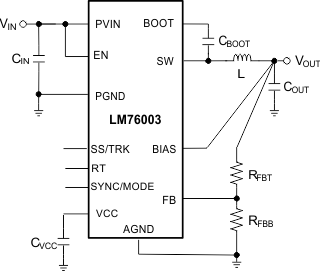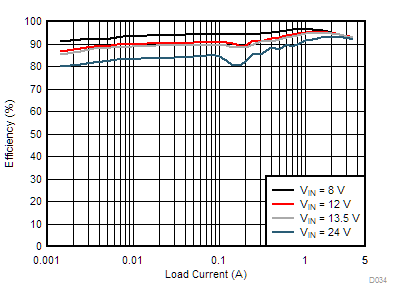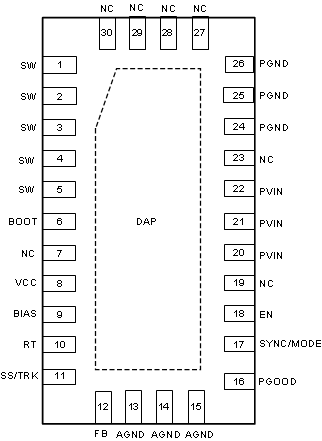-
LM7600x-Q1 3.5V 至 60V、2.5A/3.5A 同步降压稳压器 ZHCSH62B December 2017 – October 2019 LM76002-Q1 , LM76003-Q1
PRODUCTION DATA.
-
LM7600x-Q1 3.5V 至 60V、2.5A/3.5A 同步降压稳压器
- 1 特性
- 2 应用
- 3 说明
- 4 修订历史记录
- 5 Pin Configuration and Functions
- 6 Specifications
-
7 Detailed Description
- 7.1 Overview
- 7.2 Functional Block Diagram
- 7.3
Feature Description
- 7.3.1 Fixed-Frequency, Peak-Current-Mode Control
- 7.3.2 Light Load Operation Modes — PFM and FPWM
- 7.3.3 Adjustable Output Voltage
- 7.3.4 Enable (EN Pin) and UVLO
- 7.3.5 Internal LDO, VCC UVLO, and Bias Input
- 7.3.6 Soft Start and Voltage Tracking (SS/TRK)
- 7.3.7 Adjustable Switching Frequency (RT) and Frequency Synchronization
- 7.3.8 Minimum On-Time, Minimum Off-Time, and Frequency Foldback at Dropout Conditions
- 7.3.9 Internal Compensation and CFF
- 7.3.10 Bootstrap Voltage and VBOOT UVLO (BOOT Pin)
- 7.3.11 Power Good and Overvoltage Protection (PGOOD)
- 7.3.12 Overcurrent and Short-Circuit Protection
- 7.3.13 Thermal Shutdown
- 7.4 Device Functional Modes
-
8 Application and Implementation
- 8.1 Application Information
- 8.2
Typical Applications
- 8.2.1 Design Requirements
- 8.2.2
Detailed Design Procedure
- 8.2.2.1 Custom Design With WEBENCH® Tools
- 8.2.2.2 Output Voltage Setpoint
- 8.2.2.3 Switching Frequency
- 8.2.2.4 Input Capacitors
- 8.2.2.5 Inductor Selection
- 8.2.2.6 Output Capacitor Selection
- 8.2.2.7 Feed-Forward Capacitor
- 8.2.2.8 Bootstrap Capacitors
- 8.2.2.9 VCC Capacitors
- 8.2.2.10 BIAS Capacitors
- 8.2.2.11 Soft-Start Capacitors
- 8.2.2.12 Undervoltage Lockout Setpoint
- 8.2.2.13 PGOOD
- 8.2.2.14 Synchronization
- 8.2.3 Application Curves
- 9 Power Supply Recommendations
- 10Layout
- 11器件和文档支持
- 12机械、封装和可订购信息
- 重要声明
DATA SHEET
LM7600x-Q1 3.5V 至 60V、2.5A/3.5A 同步降压稳压器
本资源的原文使用英文撰写。 为方便起见,TI 提供了译文;由于翻译过程中可能使用了自动化工具,TI 不保证译文的准确性。 为确认准确性,请务必访问 ti.com 参考最新的英文版本(控制文档)。
1 特性
- 具有符合面向汽车应用的 AEC-Q100 标准
- 器件温度 1 级:-40℃ 至 +125℃ 的环境运行温度范围
- 器件 HBM ESD 分类等级 2
- 器件 CDM ESD 分类等级 C5
- 集成同步整流
- 输入电压 3.5V 至 60V(最大值 65V)
- 输出电压 1V 至 95% VIN
- 稳压静态电流 15µA
- 宽电压转换范围
- tON-MIN = 65ns(典型值)
- tOFF-MIN = 95ns(典型值)
- 系统级 特性
- 与外部时钟保持同步
- 电源正常状态标志
- 可调软启动(默认为 6.3ms)
- 引脚可选式 FPWM 运行
- 可调频率范围:300kHz 至 2.2MHz
- 在轻负载架构下实现高效率 (PFM)
- 保护 功能
- 逐周期电流限制
- 具有断续模式的短路保护
- 过热关断保护
- 使用 LM76002-Q1η/LM76003-Q1 并借助 WEBENCH® 电源设计器创建定制设计方案
3 说明
LM76002-Q1/LM76003-Q1 稳压器是一款易于使用的同步降压直流/直流转换器,能驱动高达 2.5A (LM76002-Q1) 或 3.5A (LM76003-Q1) 的负载电流,输入电压最高可达 60V。LM76002-Q1/LM76003-Q1 解决方案尺寸极小,但能提供优异的效率和输出精度。采用峰值电流模式控制。可调 特性 (例如可调开关频率、同步、FPWM 选项、电源正常状态标志、精密使能端、可调式软启动和跟踪)可为各种应用提供灵活且简单易用的 解决方案。轻负载时的自动频率折返和可选的外部偏置电源可以提高效率。该器件需要极少的外部组件,其引脚专为简化 PCB 布局而设计,可提供优异的 EMI (CISPR25) 和热性能。保护 功能 包括输入欠压锁定、热关断、逐周期电流限制和短路保护。LM76002-Q1/LM76003-Q1 器件采用 WQFN 30 引脚无引线式封装,且具有可湿性侧面。
器件信息(1)
| 器件型号 | 封装 | 封装尺寸(标称值) |
|---|---|---|
| LM76002-Q1 | WQFN (30) | 6.00mm × 4.00mm |
| LM76003-Q1 |
- 如需了解所有可用封装,请参阅数据表末尾的可订购产品附录。
空白
简化原理图

效率与输出电流
(VOUT = 5V,fSW = 400kHz,自动模式)

4 修订历史记录
Changes from A Revision (November 2018) to B Revision
- Updated the Thermal Information table.Go
- Changed Figure 17Go
- Updated Power Good and Overvoltage Protection (PGOOD) sectionGo
5 Pin Configuration and Functions
RNP Package
30-Pin WQFN
Top View

Pin Functions
| PIN | I/O(1) | DESCRIPTION | |
|---|---|---|---|
| NO. | NAME | ||
| 1, 2, 3, 4, 5 | SW | P | Switching output of the regulator. Internally connected to source of the HS FET and drain of the LS FET. Connect to power inductor and boot-strap capacitor. |
| 6 | BOOT | P | Boot-strap capacitor connection for high-side driver. Connect a high-quality 470-nF capacitor from this pin to the SW pin. |
| 7, 19, 23, 27, 28, 29, 30 | NC | — | Not internally connected. Connect to ground copper on PCB to improve heat-sinking of the device and board level reliability. |
| 8 | VCC | P | Output of internal bias supply. Used as supply to internal control circuits. Connect a high-quality 2.2-µF capacitor from this pin to GND. TI does not recommended loading this pin by external circuitry. |
| 9 | BIAS | P | Optional BIAS LDO supply input. TI recommends tying this to VOUT when 3.3 V ≤ VOUT ≤ 18 V, or tying to an external 3.3-V or 5-V rail if available, to improve efficiency. When used, place a 1-µF capacitor from this terminal to ground. Tie to ground when not in use. |
| 10 | RT | A | Switching frequency setting pin. Place a resistor from this pin to ground to set the switching frequency. If floating, the default switching frequency is 500 kHz. Do not short to ground. |
| 11 | SS/TRK | A | Soft-start-control pin. Leave this pin floating to use the 6.3-ms internal soft-start ramp. An external capacitor can be connected from this pin to ground to extend the soft-start time. A 2-µA current sourced from this pin can charge the capacitor to provide the ramp. Connect to external ramp for tracking. Do not short to ground. |
| 12 | FB | A | Feedback input for output voltage regulation. Connect a resistor divider to set the output voltage. Never short this terminal to ground during operation. |
| 16 | PGOOD | A | Open-drain power-good flag output. Connect to suitable voltage supply through a current limiting resistor. High = VOUT regulation OK, Low = VOUT regulation fault. PGOOD = Low when EN = Low. |
| 17 | SYNC/MODE | A | Synchronization input and mode setting pin. Do not float, tie to ground if not used. Tie to ground: DCM/PFM operation under light loads, improved efficiency; tie to logic high: forced PWM under light loads, constant switching frequency over load; tie to external clock source: synchronize switching action to the clock, forced PWM under light loads. Triggers on the rising edge of external clock. |
| 18 | EN | A | Precision-enable input to regulator. Do not float. High = on, Low = off. Can be tied to VIN. Precision-enable input allows adjustable UVLO by external resistor divider. |
| 13, 14, 15 | AGND | G | Analog ground. Ground reference for internal references and logic. All electrical parameters are measured with respect to this pin. Connect to system ground on PCB. |
| 20, 21, 22 | PVIN | P | Supply input to internal bias LDO and HS FET. Connect to input supply and input bypass capacitors CIN. CIN must be placed right next to this pin and PGND and connected with short traces. |
| 24, 25, 26 | PGND | G | Power ground, connected to the source of LS FET internally. Connect to system ground, DAP/EP, AGND, ground side of CIN and COUT. Path to CIN must be as short as possible. |
| EP | DAP | — | Low impedance connection to AGND. Connect to system ground on PCB. Major heat dissipation path for the die. Must be used for heat sinking by soldering to ground copper on PCB. Thermal vias are preferred. |
(1) A = Analog, O = Output, I = Input, G = Ground, P = Power
6 Specifications
6.1 Absolute Maximum Ratings
over operating free-air temperature range of –40°C to +125°C (unless otherwise noted)(1)(1) Stresses beyond those listed under Absolute Maximum Ratings may cause permanent damage to the device. These are stress ratings only, which do not imply functional operation of the device at these or anyother conditions beyond those indicated under Recommended OperatingConditions. Exposure to absolute-maximum-rated conditions for extended periods may affect device reliability.
6.2 ESD Ratings
| VALUE | UNIT | |||
|---|---|---|---|---|
| V(ESD) | Electrostatic discharge | Human-body model (HBM), per AEC Q100-002(1) | ±2000 | V |
| Charged-device model (CDM), per AEC Q100-011 | ±750 | V | ||
(1) AEC Q100-002 indicates that HBM stressing shall be in accordance with the ANSI/ESDA/JEDEC JS-001 specification.
6.3 Recommended Operating Conditions
over operating free-air temperature range (unless otherwise noted)(1)(1) Recommended operating rating indicate conditions for which the device is intended to be functional, but do not ensure specific performance limits. For ensured specifications, see Electrical Characteristics.
6.4 Thermal Information
| THERMAL METRIC(1) | LM76002/LM76003 | UNIT | |
|---|---|---|---|
| RNP (WQFN) | |||
| 30 PINS | |||
| RθJA | Junction-to-ambient thermal resistance | 29.6 | °C/W |
| RθJC(top) | Junction-to-case (top) thermal resistance | 17.6 | °C/W |
| RθJB | Junction-to-board thermal resistance | 9.1 | °C/W |
| ψJT | Junction-to-top characterization parameter | 0.2 | °C/W |
| ψJB | Junction-to-board characterization parameter | 9.0 | °C/W |
| RθJC(bot) | Junction-to-case (bottom) thermal resistance | 1.0 | °C/W |
(1) For more information about traditional and new thermal metrics, see the Semiconductor and IC Package Thermal Metrics application report.